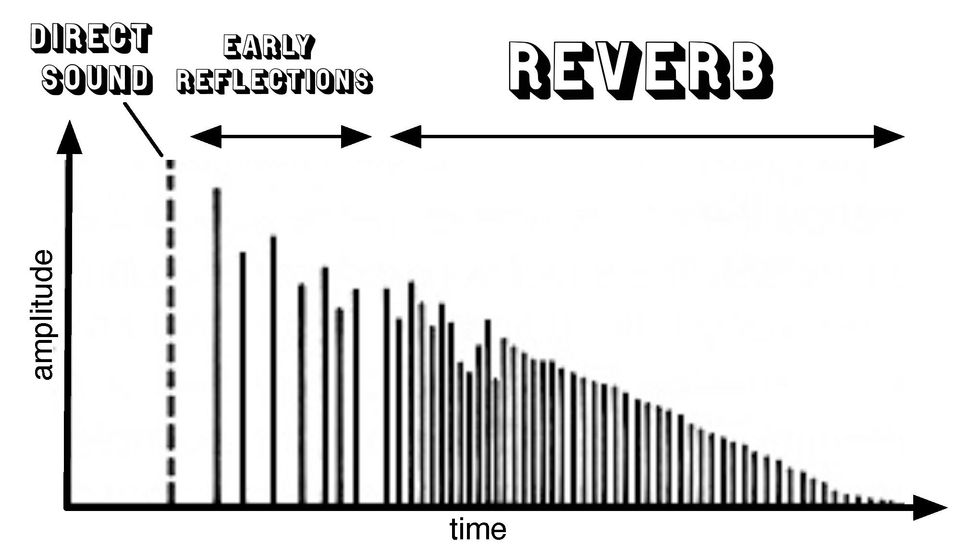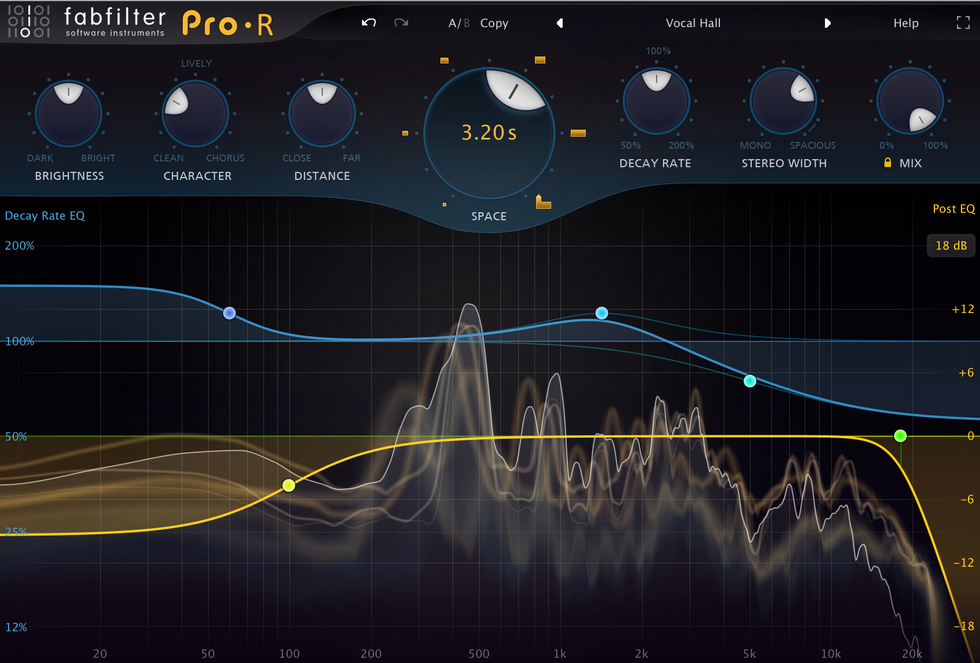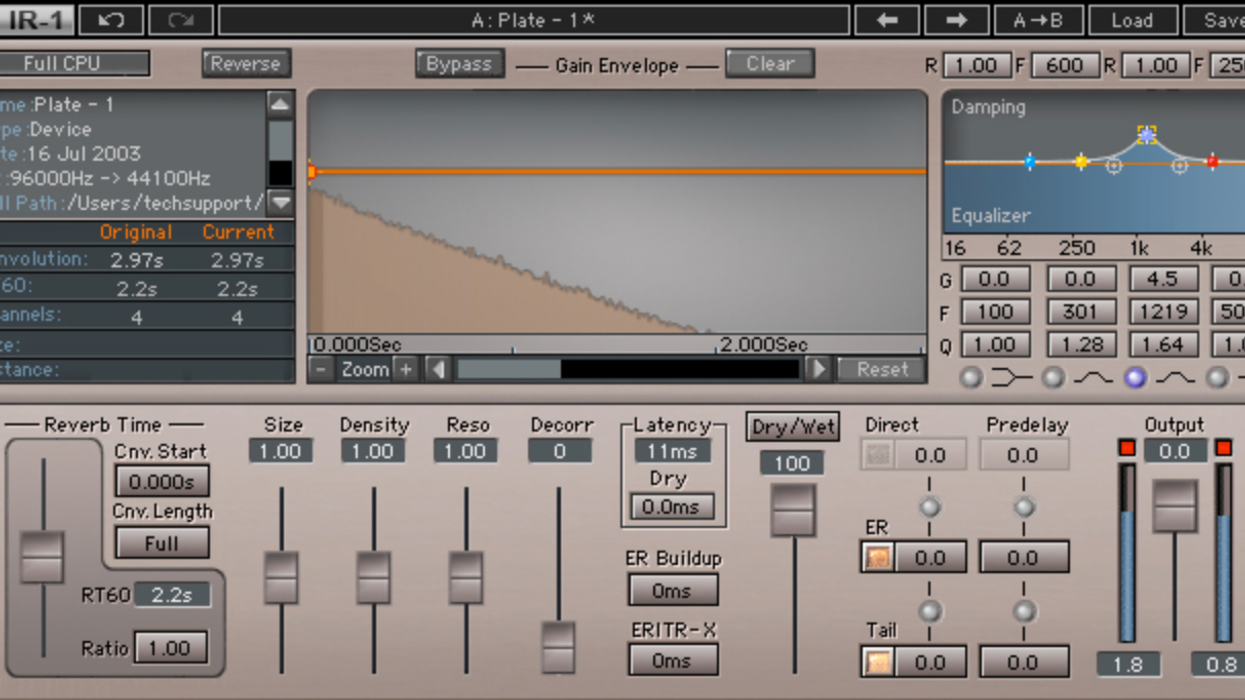Welcome back to another Dojo. Last month, I shed light on the benefits of room recording and using the natural reverb of given spaces. This time I'll briefly explain reverb's four main parameters in layman's terms (it's actually a very deep and complex subject), and, by tweaking those parameters, how to make new, interesting, and physically impossible spaces for use in your recordings.
Most of us add reverb at some point in our recording process, and most of that is through digital plug-ins found in our DAW or by third-party makers (FabFilter, Waves, Universal Audio, etc.) or through rackmounted outboard gear. (Photos 1 and 2 provide a look at the Waves Audio's IR-1 and FabFilter's Pro R in action.) Whatever type of reverb you add, I'd be willing to bet that your process might be similar to this: pull up a reverb, set the amount of wet/dry, maybe tweak the overall time, and you're done. But there's so much more you can do!
I'd be willing to bet that your process might be similar to this: pull up a reverb, set the amount of wet/dry, maybe tweak the overall time, and you're done. But there's so much more you can do!
First, let's look at the main parameters of reverb. In any given space (size doesn't matter), something has to happen that sets sound pressure waves in motion. This is called an impulse function (a loud clap, popping a balloon, a righteous, single, 100-watt djent, etc.). The measurement of that impulse function is called the impulse response (IR). The impulse response contains four main parameters of what we generally call reverb.

Fig. 1
Imagine Metallica is doing a soundcheck at your local stadium and they're going to perform "Damage, Inc." (Still one of my favorite songs!) You're in front-of-house position (FOH), where the mix engineer sits. After the layered reversed guitar intro (lasting 1:18, for those listening at home), the band kicks in with those devastating, staccato, "chunks." With each one, several things happen in rapid succession—remember, I'm relating this as simply as possible as it's really complex. Look at Fig.1. You'll see the:
- Direct sound: A certain amount of sound reaches your ears directly, without reflecting off anything. Obviously, you hear this first.
- Early reflections: These initial reflections are easy to hear and generally bounce off a few things before reaching your ears and arrive closely after the direct sound.
- Reverb: As more reflected sounds reach your ears with mosh-pit ferocity, the ears can no longer make out individual early reflections because of the buildup, and "reverb" starts.Length: Once reverb starts, the time it takes for the sound to bounce off the rafters and for the venue to eventually fall silent again is known as the reverb time or RT60. RT60 is generally the amount of time it takes for the IR to fade 60 dB and merge back with the inherent noise floor of the building.
- Length: Once reverb starts, the time it takes for the sound to bounce off the rafters and for the venue to eventually fall silent again is known as the reverb time or RT60. RT60 is generally the amount of time it takes for the IR to fade 60 dB and merge back with the inherent noise floor of the building.
Okay, now let's get down to business. Most reverb plug-ins allow you to adjust time, EQ, pre-delay, and mix (wet/dry). Some, like Waves IR-1 reverb ($29 street) and FabFilter's Pro R ($199 street) offer much more, but in very different ways.
Adjusting the Pre-Delay

Photo 2 : FabFilter's Pro R
Increasing the pre-delay will postpone the arrival time of reverb. Which means that you can easily defy the laws of physics. Since sound travels at 1,125 feet per second (at 68 degrees Fahrenheit at sea level), by adjusting the pre-delay, you can move the arrival time of the reverb to a later point (that's not physically possible), yet when the reverb actually starts, it goes back to obeying the laws of physics. This trick is often used to bring clarity to an instrument's articulation and to subtle parameters that might be getting washed out in the original reverb. This works extremely well on vocals, snare drum, acoustic guitars, staccato power chords, etc. Further, some pre-delay settings can be synced (quarter-, eighth-, 16th-note, etc.) to the BPM of the song. FabFilter's Pro R does this, again violating the laws of physics. Adding even more violations to the properties of sound, Waves IR will allow you to add a pre-delay to the early reflections before reverb.
Adjusting the EQ
Adjusting the reverb's EQ can add another layer of complexity. Boosting top end to make it brighter can make a heavily pre-delayed reverb sound like it would if it were closer to the source, but, because of the pre-delay, it would organically sound dark and dull. One other thing to try is adding a narrow Q to a frequency band (or several) and tuning your reverb to the key or a specific harmony you wish.
I encourage you to play with all the available parameters as much as you can and see what kind of craziness you can come up with. I'll be sharing some of mine on my website, bryanclarkmusic.com, should you want to see and hear some more examples. Until next time, stay open-minded and keep rocking! Namaste.









![Rig Rundown: AFI [2025]](https://www.premierguitar.com/media-library/youtube.jpg?id=62064741&width=1245&height=700&quality=70&coordinates=0%2C0%2C0%2C0)





